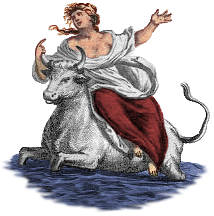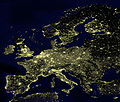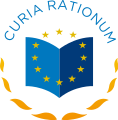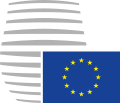Portal:European Union
Introduction
The European Union (EU) is a supranational political and economic union of 27 member states that are located primarily in Europe. The union has a total area of 4,233,255 km2 (1,634,469 sq mi) and an estimated total population of over 449 million. The EU has often been described as a sui generis political entity combining the characteristics of both a federation and a confederation. Containing 5.8% of the world population in 2020, EU member states generated a nominal gross domestic product (GDP) of around US$16.6 trillion in 2022, constituting approximately one sixth of global nominal GDP. Additionally, all EU states except Bulgaria have a very high Human Development Index according to the United Nations Development Programme. Its cornerstone, the Customs Union, paved the way to establishing an internal single market based on standardised legal framework and legislation that applies in all member states in those matters, and only those matters, where the states have agreed to act as one. EU policies aim to ensure the free movement of people, goods, services and capital within the internal market; enact legislation in justice and home affairs; and maintain common policies on trade, agriculture, fisheries and regional development. Passport controls have been abolished for travel within the Schengen Area. The eurozone is a group composed of the 20 EU member states that have fully implemented the economic and monetary union and use the euro currency. Through the Common Foreign and Security Policy, the union has developed a role in external relations and defence. It maintains permanent diplomatic missions throughout the world and represents itself at the United Nations, the World Trade Organization, the G7 and the G20. Due to its global influence, the European Union has been described by some scholars as an emerging superpower. In 2012, the EU was awarded the Nobel Peace Prize. The United Kingdom became the only member state to leave the EU, in 2020; ten countries are aspiring or negotiating to join it. (Full article...) Selected article The International Court of Justice (known colloquially as the World Court or ICJ) is the principal judicial organ of the United Nations. Its seat is in the Peace Palace at The Hague, Netherlands. Established in 1945 by the Charter of the United Nations, the Court began work in 1946 as the successor to the Permanent Court of International Justice. The Statute of the International Court of Justice, similar to that of its predecessor, is the main constitutional document constituting and regulating the Court. The ICJ should not be confused with the International Criminal Court or a court exercising jurisdiction under Belgium's War Crimes Law, both of which also potentially have "global" jurisdiction. English and French are its two official languages. The Court's workload is characterised by a wide range of judicial activity. Its main functions are to settle legal disputes submitted to it by states and to give advisory opinions on legal questions submitted to it by duly authorised international organs and agencies. The number of decisions made by the ICJ has been relatively small, but there has clearly been an increased willingness to use the Court since the 1980s, especially among developing countries, although the USA withdrew from compulsory jurisdiction in 1986, meaning it accepts the court's jurisdiction on only a case-to-case basis. Selected picturePainting: František Kupka The Cathedral is an abstract oil painting on canvas created by Czech artist František Kupka in 1912–1913. Measuring 180 by 150 centimetres (71 in × 59 in), the painting is held by the Museum Kampa in Prague, Czech Republic. In this painting, vertical lines running the entire length of the canvas are intersected by diagonal lines to form rectilinear shapes of various sizes and colors.
Did you know?...that the President of Ireland, who serves as head of state, is elected for a seven year term and can be re-elected only once? ...that within the Eurozone the European Central Bank has the exclusive authority to set monetary policy? Selected cityTallinn is the capital city and main seaport of Estonia. It is situated on the southern coast of the Gulf of Finland, in north central Estonia., 80 kilometres south of Helsinki. Tallinn's population is registered at 399,180 (as of November 2006). In 1154 Tallinn was marked on the world map of the Arab cartographer al-Idrisi. As an important port for trade between Russia and Scandinavia, it became a target for the expansion of the Teutonic Knights and Kingdom of Denmark during the period of Northern Crusades in the beginning of the 13th century when Christianity was forcibly imposed on the local population. Danish rule of Tallinn and Northern Estonia started in 1219. According to Eurostat, the statistical agency of the European Union, of all EU member states' capital cities, Tallinn has the largest number of non-EU nationals: 27.8% of its population are not EU citizens. General imagesThe following are images from various European Union-related articles on Wikipedia.
TopicsFeatured contentFeatured articles
Featured lists
Featured contentGood articles
CategoriesRelated portalsAssociated WikimediaThe following Wikimedia Foundation sister projects provide more on this subject:
Discover Wikipedia using portals |



































































